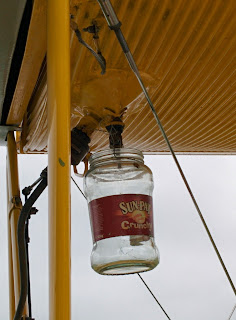 |
| This post is not sponsored by the makers of Sun Pat crunchy peanut butter. Tasty as it is, I wouldn't like to eat any from this jar. |
It's only a small leak: just a drop now and then. You don't even notice it when flying. But overnight, it drips onto the cloth cover, which is not good for it. How can we solve this problem? Actually fixing the tap takes a while, because you need specially certified parts, and a qualified mechanic has to sign off the repair as airworthy. After all, if the tap fell off in flight, that would be a much bigger problem. So until we can do that, here's something that can't possibly cause a problem in flight. A length of thin wire, wound round the neck of the jar, is bent into two loops, which hang over either end of the tap. Simply unhook them from the tap before you start the engine.
Now it's even quicker to take the fuel sample every morning: the sample is in the jar ready and waiting for you to test!
This is the engineering spirit that helped this particular aircraft survive the Battle of France.
No comments:
Post a Comment